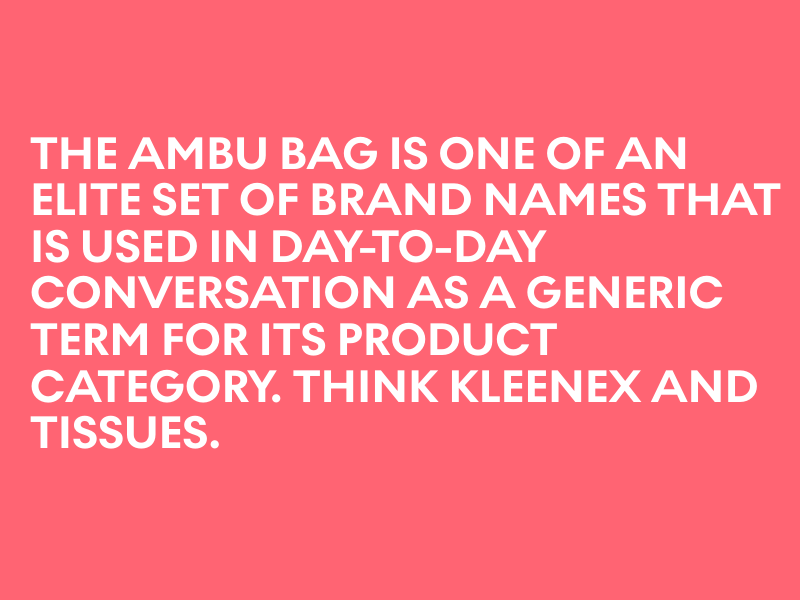The Ambu Bag was seen in Marvel Studios' Captain America: The Winter Soldier

A Brand Standard of Care
When a manual resuscitator is needed to save a life, real doctors, like their fictional counterparts on TV and in movies, often call for an “Ambu Bag” as if on cue.
Other brands have copied the original Ambu® Bag™ resuscitator since it was invented in 1956 — but the name that rings out at hospital bedsides, accident scenes, and across emergency rooms around the world is “Ambu Bag."
That’s because the Ambu Bag is one of an elite set of brand names that is used in day-to-day conversation as a generic term for its product category. The Ambu Bag, in other words, has become synonymous with the manual resuscitator — think Kleenex and tissues.
There are many more: Band-Aid, Jell-O, Zipper, Popsicle, Scotch-Tape, Windex, Q-Tips, Kool-Aid, Jet Ski, Post-It Note, Chapstick, Tabasco, PowerPoint, Sharpie, Bubble Wrap. The list goes on.
The Name That Sticks
“It’s a valuable piece of resuscitation equipment, considered to be standard of care” says Felix Khusid, RRT, a respiratory therapist and president of the New York Downstate Association for Respiratory Therapists (NYDART), who counts an authentic Ambu Bag from the 1960s among the pieces in his museum collection. “Everybody refers to every manual resuscitator as an Ambu Bag.” Created in 1956, the Ambu Bag quickly won international attention. It was recognized as a major milestone in emergency equipment and hospital care, and it has stayed that way ever since.
Created in 1956, the Ambu Bag quickly won international attention. It was recognized as a major milestone in emergency equipment and hospital care, and it has stayed that way ever since.
“Ambu is the name that sticks,” says Dave Carter, a veteran respiratory therapist who has used the device thousands of times in his career. “It's like Coke is the representative of all soft drinks.”
Ambu is the “gold standard,” and there's a reason for that says Lt. Jeff Berry, with East Pierce Fire & Rescue in Washington.
“It's the Xerox machine,” he says. “Regardless of the brand, it's an Ambu Bag. And that's because you guys wrote the book on resuscitators. And I suppose there's a lot of pressure that comes with that too, to stay out ahead of the rest of the curve. Because everybody's always trying to make a better mousetrap, right?”
Brands That Deliver
He divides manufacturers into two categories, citing brands like Kraft Macaroni & Cheese and Oscar Mayer Wieners as examples.
“I mean, there are companies that made those products what they are, and then there's the generics that came behind them,” Berry says. “That's kind of what Ambu is to the bag valve mask.”
There are many recent instances of brands becoming synonymous with their product category, says Shana Harris, chief operating officer at Warschawski in Baltimore and a brand expert.
Uber, for instance, has come to refer to any time you hail a car to get somewhere — indeed, its name is used as a verb, much like Google. Other modern terms, such as Siri or Airbnb, are further examples of a brand name used interchangeably with a generic category.
Often, it’s the product that’s first to market that wins out, with competitors having to work hard to catch up, Harris says. But being first doesn’t always mean you win. The product must be good, and the brand needs to deliver consistent, positive brand experiences in order to maintain that top position.
A Higher Calling
“As long as your brand delivers on its promise and continues to create a strong emotional connection with its audience, then having the brand define the category is a positive thing,” she says. “You are dominating the industry. But it comes with the responsibility to maintain all those things and the quality of the product.”
There is more at stake — and further to fall — when you are the market leader should problems arise with your product or overall brand reputation.
“You’re much more well known,” she says. Everyone is watching you.”
When an Ambu Bag appears on a show like “Grey’s Anatomy,” that boosts the brand’s credibility by positioning the company behind it as the trusted choice of healthcare professionals, even if they are of the Hollywood variety.
The branding goal, in turn, reinforces a comfort level among healthcare workers who use the device — one that focuses on the experience of using the product, rather than the product itself, Harris says.
“It’s a product you choose to save lives,” she says. “You’re talking about the higher calling that Ambu has taken on as a brand value and experience that they are delivering. They take saving lives seriously, and that comes with a huge responsibility.”

